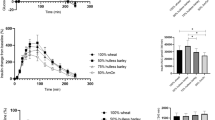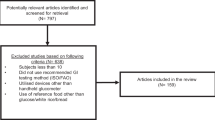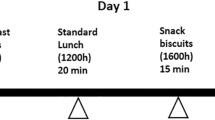Abstract
Background/Objectives:
German-style breads are recommended as a lower glycaemic index (GI) alternative, yet little data is available. Our aim was to test the GI and insulin index (II) of four breads and rolls commonly consumed in Germany.
Subjects/Methods:
Four German bread products were tested for their GI and II in 12 healthy subjects according to the International Standard Organization guidelines.
Results:
Only the wholemeal rye bread with visible intact grains and sunflower seeds was identified as low GI (GI=55). Both the wholemeal spelt wheat (GI=63) and the rye wheat sourdough bread (GI=62) were classified as medium GI, whereas soft pretzel was high GI (GI=80, P<0.05 compared with other products). The II of soft pretzels (II=102) was also highest and differed significantly from wholemeal rye (II=70) and rye sourdough bread (II=72) but not from wholemeal spelt wheat (II=77).
Conclusions:
Contrary to popular belief, these German-style breads are medium to high GI, with the exception of the rye bread with intact grains and seeds. The results highlight the need to test, rather than ‘guestimate’, the GI of local products, and develop a broader range of low-GI breads.
This is a preview of subscription content, access via your institution
Access options
Subscribe to this journal
Receive 12 print issues and online access
$259.00 per year
only $21.58 per issue
Buy this article
- Purchase on Springer Link
- Instant access to full article PDF
Prices may be subject to local taxes which are calculated during checkout

Similar content being viewed by others
References
Jenkins DJ, Wolever TM, Taylor RH, Barker H, Fielden H, Baldwin JM et al. Glycaemic index of foods: a physiological basis for carbohydrate exchange. Am J Clin Nutr 1981; 34: 362–366.
Barclay AW, Petocz P, McMillan-Price J, Flood VM, Prvan T, Mitchell P et al. Glycaemic index, glycaemic load, and chronic disease risk—a meta-analysis of observational studies. Am J Clin Nutr 2008; 87: 627–637.
Dong JY, Zhang L, Zhang YH, Qin LQ . Dietary glycaemic index and glycaemic load in relation to the risk of type 2 diabetes: a meta-analysis of prospective cohort studies. Br J Nutr 2011; 106: 1649–1654.
Greenwood DC, Threapleton DE, Evans CE, Cleghorn CL, Nykjaer C, Woodhead C et al. Glycaemic index, glycaemic load, carbohydrates, and type 2 diabetes: systematic review and dose–response meta-analysis of prospective studies. Diabetes Care 2013; 36: 4166–4171.
Liu S, Chou EL . Dietary glycaemic load and type 2 diabetes: modeling the glucose-raising potential of carbohydrates for prevention. Am J Clin Nutr 2010; 92: 675–677.
Livesey G, Taylor R, Livesey H, Liu S . Is there a dose–response relation of dietary glycaemic load to risk of type 2 diabetes? Meta-analysis of prospective cohort studies. Am J Clin Nutr 2013; 97: 584–596.
Fan J, Song Y, Wang Y, Hui R, Zhang W . Dietary glycaemic index, glycaemic load, and risk of coronary heart disease, stroke, and stroke mortality: a systematic review with meta-analysis. PLoS One 2012; 7: e52182.
Ma XY, Liu JP, Song ZY . Glycaemic load, glycaemic index and risk of cardiovascular diseases: meta-analyses of prospective studies. Atherosclerosis 2012; 223: 491–496.
Mente A, de Koning L, Shannon HS, Anand SS . A systematic review of the evidence supporting a causal link between dietary factors and coronary heart disease. Arch Intern Med 2009; 169: 659–669.
Mirrahimi A, de Souza RJ, Chiavaroli L, Sievenpiper JL, Beyene J, Hanley AJ et al. Associations of glycaemic index and load with coronary heart disease events: a systematic review and meta-analysis of prospective cohorts. J Am Heart Assoc 2012; 1: e000752.
Brand-Miller J, McMillan-Price J, Steinbeck K, Caterson I . Carbohydrates—the good, the bad and the whole grain. Asia Pac J Clin Nutr 2008; 17 (Suppl 1), 16–19.
Burton PM, Monro JA, Alvarez L, Gallagher E . Glycaemic impact and health: new horizons in white bread formulations. Crit Rev Food Sci Nutr 2011; 51: 965–982.
Max Rubner-Institut. Nationale Verzehrsstudie II. Ergebnissbericht Teil 1. Available at: www.was-esse-ich.de/uploads/media/NVSII_Abschlussbericht_Teil_1.pdf (last accessed 15 January 2014).
Roswall N, Olsen A, Boll K, Christensen J, Halkjaer J, Sorensen TI et al. Consumption of predefined 'Nordic' dietary items in ten European countries—an investigation in the European Prospective Investigation into Cancer and Nutrition (EPIC) cohort. Public Health Nutr 2014; 17: 2650–2659.
Wirfalt E, McTaggart A, Pala V, Gullberg B, Frasca G, Panico S et al. Food sources of carbohydrates in a European cohort of adults. Public Health Nutr 2002; 5: 1197–1215.
Atkinson FS, Foster-Powell K, Brand-Miller JC . International tables of glycaemic index and glycaemic load values. Diabetes Care 2008; 31: 2281–2283.
Granfeldt Y, Hagander B, Bjorck I . Metabolic responses to starch in oat and wheat products. On the importance of food structure, incomplete gelatinization or presence of viscous dietary fibre. Eur J Clin Nutr 1995; 49: 189–199.
Liljeberg H, Granfeldt Y, Bjorck I . Metabolic responses to starch in bread containing intact kernels versus milled flour. Eur J Clin Nutr 1992; 46: 561–575.
Scazzina F, Siebenhandl-Ehn S, Pellegrini N . The effect of dietary fibre on reducing the glycaemic index of bread. Br J Nutr 2013; 109: 1163–1174.
De Angelis M, Rizzello CG, Alfonsi G, Arnault P, Cappelle S, Di Cagno R et al. Use of sourdough lactobacilli and oat fibre to decrease the glycaemic index of white wheat bread. Br J Nutr 2007; 98: 1196–1205.
Novotni D, Curic D, Bituh M, Colic Baric I, Skevin D, Cukelj N . Glycaemic index and phenolics of partially-baked frozen bread with sourdough. Int J Food Sci Nutr 2011; 62: 26–33.
International Standards Organisation Food Products—Determination of the Glycaemic Index (GI) and Recommendation for Food Classification, ISO 26642-2010. International Organisation for Standardisation: Geneva, Switzerland, 2010.
Fardet A . New hypotheses for the health-protective mechanisms of whole-grain cereals: what is beyond fibre? Nutr Res Rev 2010; 23: 65–134.
Jenkins DJ, Wesson V, Wolever TM, Jenkins AL, Kalmusky J, Guidici S et al. Wholemeal versus wholegrain breads: proportion of whole or cracked grain and the glycaemic response. BMJ 1988; 297: 958–960.
Najjar AM, Parsons PM, Duncan AM, Robinson LE, Yada RY, Graham TE . The acute impact of ingestion of breads of varying composition on blood glucose, insulin and incretins following first and second meals. Br J Nutr 2009; 101: 391–398.
Liljeberg HG, Lonner CH, Bjorck IM . Sourdough fermentation or addition of organic acids or corresponding salts to bread improves nutritional properties of starch in healthy humans. J Nutr 1995; 125: 1503–1511.
Rosen LA, Silva LO, Andersson UK, Holm C, Ostman EM, Bjorck IM . Endosperm and whole grain rye breads are characterized by low post-prandial insulin response and a beneficial blood glucose profile. Nutr J 2009; 8: 42.
International Diabetes Federation IDF Diabetes Atlas 6th edn International Diabetes Federation: Brussels, Belgium, 2013.
Moazzami AA, Shrestha A, Morrison DA, Poutanen K, Mykkanen H . Metabolomics reveals differences in postprandial responses to breads and fasting metabolic characteristics associated with postprandial insulin demand in postmenopausal women. J Nutr 2014; 144: 807–814.
Ferrer-Mairal A, Penalva-Lapuente C, Iglesia I, Urtasun L, De Miguel-Etayo P, Remon S et al. In vitro and in vivo assessment of the glycaemic index of bakery products: influence of the reformulation of ingredients. Eur J Nutr 2012; 51: 947–954.
Radhika G, Sumathi C, Ganesan A, Sudha V, Jeya Kumar Henry C, Mohan V . Glycaemic index of Indian flatbreads (rotis) prepared using whole wheat flour and 'atta mix'-added whole wheat flour. Br J Nutr 2010; 103: 1642–1647.
Buyken AE, Toeller M, Heitkamp G, Karamanos B, Rottiers R, Muggeo M et al. Glycaemic index in the diet of European outpatients with type 1 diabetes: relations to glycated hemoglobin and serum lipids. Am J Clin Nutr 2001; 73: 574–581.
Henry CJ, Lightowler HJ, Tydeman EA, Skeath R . Use of low-glycaemic index bread to reduce 24-h blood glucose: implications for dietary advice to non-diabetic and diabetic subjects. Int J Food Sci Nutr 2006; 57: 273–278.
Salmeron J, Ascherio A, Rimm EB, Colditz GA, Spiegelman D, Jenkins DJ et al. Dietary fiber, glycaemic load, and risk of NIDDM in men. Diabetes Care 1997; 20: 545–550.
Stevens J, Ahn K, Juhaeri, Houston D, Steffan L, Couper D . Dietary fiber intake and glycaemic index and incidence of diabetes in African-American and white adults: the ARIC study. Diabetes Care 2002; 25: 1715–1721.
van Bakel MM, Kaaks R, Feskens EJ, Rohrmann S, Welch AA, Pala V et al. Dietary glycaemic index and glycaemic load in the European Prospective Investigation into Cancer and Nutrition. Eur J Clin Nutr 2009; 63 (Suppl 4), S188–S205.
Acknowledgements
We thank Lieken Urkorn for providing two of the breads and sponsoring their transport to Sydney, Australia. Furthermore, we thank the SUGiRS staff, particularly Karola Landrey, Courtney J Wright and Alisha Li, for helping with the organization of the GI/II testing in the metabolic kitchen, with the processing of the blood samples and with the conduction of the glucose and insulin analyses.
Author contributions
AEB, JBM and JG conceived the project; AEB and JG selected the breads; FA and KLE supervised the testing procedures and data interpretation; KB assisted in the II result interpretation; JG conducted the GI/II testing, undertook statistical analyses, interpreted the findings and wrote the manuscript; and all authors read and approved the final manuscript.
Author information
Authors and Affiliations
Corresponding author
Ethics declarations
Competing interests
JBM is a coauthor of The Low GI Handbook book and other books (DeCapo, New York), President of the Glycaemic Index Foundation and Director of a non-profit GI-based food endorsement programme in Australia and manages the University of Sydney GI testing service. The remaining authors declare no conflict of interest.
Rights and permissions
About this article
Cite this article
Goletzke, J., Atkinson, F., Ek, K. et al. Glycaemic and insulin index of four common German breads. Eur J Clin Nutr 70, 808–811 (2016). https://doi.org/10.1038/ejcn.2016.9
Received:
Revised:
Accepted:
Published:
Issue Date:
DOI: https://doi.org/10.1038/ejcn.2016.9



